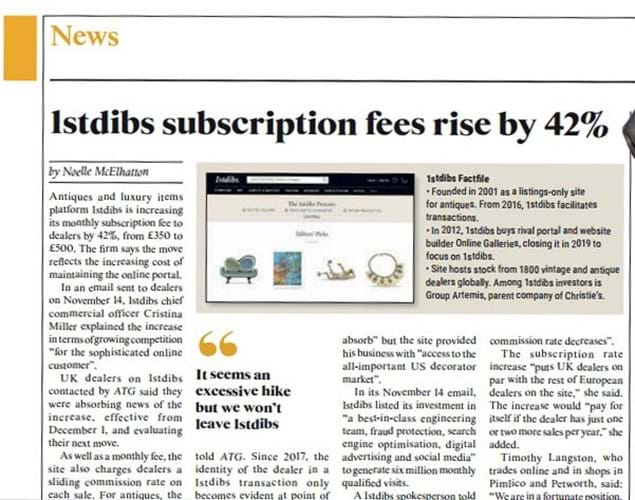
One of several crises in the trade the last few weeks is the huge increase in fees now charged by 1st dibs, one of the major online platforms for art and antiques. In response to the complaints of the dealers who maintain a virtual storefront on this platform, Antiques Trade Gazette reports 1st dibs claims the move is necessary to maintain its advertising, fraud protection, website optimization, and social media presence. All this to court, as mentioned obliquely by 1st dibs in its communication to dealers, ‘the sophisticated online customer.’
Well, maybe. But the more likely explanation is the simpler one- a naked move to quickly increase revenue for the owners of the platform. I had some time ago formed the opinion, or should I say joined the chorus of opinion, that this same platform sought to be the overarching presence in the trade, doing its level best to become a clearing house for all manner of luxury goods by occluding as best it could the dealers whose virtual storefronts provide the subscription revenue that provides the lion’s share of the site’s income. In so doing, prospective buyers, who might prefer to trade directly with the dealer, are then forced to deal directly with the platform when making a purchase. The platform itself can then charge the dealer a commission on the sale, on top of the monthly subscription fee charged the dealer for its online storefront. Frankly, we did at one time have a storefront on this platform, but when it became obvious they sought to make every effort to come between us and the buyer, we left. For Chappell & McCullar, indeed for nearly every dealer in the accredited trade, the art and antiques business remains a relationship one- even with so much of our trade now through our own website, the Chappell & McCullar ‘look’ is like that of no one else. The same can be said for any other dealer- as has become my mantra, it is the dealer’s taste, expertise and reputation that the buyer is purchasing, not just its stock in trade.
And of course, that is what 1st dibs sought to extinguish- substituting its own self as less the keeper than an aggregator of relationships while making the dealers who’ve maintained virtual storefronts almost entirely anonymous. In all honesty, had we been selling well on the platform, we’d probably, venal folk that we are, continued to subscribe. But we didn’t, and found ourselves paying more and more in fees, and the only occasional sale when it happened was for lower priced material that barely covered the cost of listing the item. And, and a very important and, whatever sales we had were of the one-off, spot sale variety- buyers with whom we never established any sort of relationship and beyond the single sale, never saw again.
Any business is entitled to make money and the bigger and more predominant it is within its industry, the more predacious its practices might seem. But 1st dibs has long sought to marshal the selling of items, taking advantage of a trade made up of innumerable small players who in their fearful desire to stay in business felt they had no choice but to add a virtual storefront to their bag of tricks. Traditional sales outlets of the bricks and mortar variety and the occasional fairs have not been enough for years. Indeed, the online platform has generally subsumed the traditional venues. Fairs, for decades the traditional buying opportunity in locations around the world exist in dwindling numbers, and bricks and mortar venues find themselves bereft of dealers, particularly those of period material. Indeed, our old Jackson Square neighborhood in San Francisco, once the home of nearly 30 dealers within a couple of blocks of one another, now has nary a one. At one time, 1st dibs itself was a sponsor of very many of the major fairs, particularly in the US. That, though, hasn’t happened for some years. It must consider fair advertising and promotion unnecessary, as it has itself become the country’s major, albeit virtual, fair.
Now, though, all manner of platforms have become ubiquitous. We get invites to list on a different one several times a week- tempting to take a flyer, as the introductory listing fees are always quite low. And indeed, most of the trade associations maintain platforms- not for free, but at least a dealer feels as a member of the association one is, to an extent, paying a listing or subscription fee at least partly to oneself. Even some of the online auction websites are offering dealers virtual storefronts, and as I mention it, adding online auctions into the mix, there now exists a bewildering plethora of platforms on which a prospective buyer may make purchases.
But here’s the problem for 1st dibs- the diffusion of online platforms has become so great, and the comparative ease of establishing a platform and the cost to do so so low, platforms themselves once online are hard at it to make money. And this phenomenon does not even begin to address the attrition of dealers, witness their thinness on the ground in traditional venues, that also functions to shrink platforms’ subscription fees. 1st dibs far more than any other platform is investor heavy- investors include Christie’s parent company Group Artemis- with round after round of capitalization in order to finance the building of a business that sought to dominate the industry. But clearly, as investors do, they want a payoff. That payoff is apparently to be backbreakingly borne by their remaining cadre of subscriber dealers. Where formerly 1st dibs would introduce new fees, seek to occlude dealers in order to increase its direct commission on sales, and, a traditional tactic, increase subscription and listing fees for storefronts once a dealer’s introductory rate had expired, it now feels compelled in one fell swoop to hugely raise subscriptions across the board.
